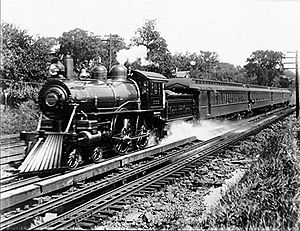West Albany, New York facts for kids
Quick facts for kids
West Albany
|
|
|---|---|
| Etymology: for being west of the city of Albany | |
| Country | United States |
| State | New York |
| Region | Capital District |
| County | Albany |
| Settled | 1850s |
| Time zone | UTC−5 (EST) |
| • Summer (DST) | UTC−4 (EDT) |
| ZIP Code |
12205
|
| Area code(s) | 518 |
West Albany is a small community called a hamlet in the town of Colonie, Albany County, New York. It's located right next to the city of Albany. Some parts of Albany are also considered West Albany, especially around the large West Albany Rail Yard.
Long ago, West Albany was a very busy place with many industries. It had one of the biggest cattle stockyards in the United States. There was also a huge railroad switching yard and a meat packing plant called Tobin First Prize. Today, these big industries are gone. West Albany is now mostly a residential area, meaning people live there. It's like a suburb of Albany.
West Albany has always been a place where many different cultures came together. People from Poland, Italy, Ireland, Germany, and England moved here. They were looking for jobs at the West Albany Rail Yard, which once had over 5,000 workers. Even today, the community is diverse. You can find places like the Polish American Citizens Club and the West Albany Italian Benevolent Society. There's also a Hebrew Academy and a Korean worship center.
History
West Albany has a rich history, especially because of its connection to railroads and large industries.
Early Beginnings

In the 1850s, a man named Andrew R. Hunter bought a lot of land in what would become West Albany. He divided the land into smaller plots and sold them to people who wanted to build homes. Many people say he helped create West Albany.
However, it was the industries that truly made West Albany famous. In 1860, the cattle stockyards moved here from Albany. They quickly became very important across the country. By the late 1880s, they were almost as big as the stockyards in Chicago and Buffalo. Sometimes, they were even busier!
The community grew quickly because of the railroads, stockyards, and meat packing businesses. A post office opened in 1862. By 1865, a horse railway was extended to West Albany. This was an early form of public transportation.
Railroads and Industry
The railroads were key to West Albany's growth. In 1844, the railroad track between Albany and Schenectady was moved. It now ran through West Albany. In 1853, several railroads joined to form the New York Central Railroad (NYC). Soon after, they started building a huge rail yard in West Albany.
The NYC bought about 250 acres of land for the yard in 1854. Later, they added another 100 acres. At its busiest time around 1900, the NYC shops at the West Albany Yard employed over 6,000 people.
In 1893, these shops built a special train called Engine 999. It was built to win a competition for the world's fastest steam locomotive. Engine #999 won! It reached 102.8 miles per hour, making it the first locomotive to go over 100 miles per hour. Today, you can see Engine #999 at the Museum of Science and Industry in Chicago.
Over time, the building of new locomotives moved to other companies. The last steam engine was repaired at West Albany in 1952. The train car repair shops closed in 1954. Most of the buildings were taken down in 1964. Today, the West Albany Industrial Park stands on much of the old rail yard site. A small freight car operation still exists, and the main tracks are used by freight and Amtrak passenger trains.
West Albany was once a major railroad hub. Trains from New England and New York City met here to travel west. However, the "West Albany Hill" was very steep. This made it hard for trains to pass through. By 1922, a new route was built called the Castleton Cutoff. This included the Alfred H. Smith Memorial Bridge and the Selkirk Yard. This new route allowed trains to bypass Albany completely.
End of an Era
The tradition of meat processing in West Albany continued for many years. The Tobin Packing Company kept the industry alive even after the railroads left. The Albany Packing Company started in 1924. It later joined with another company to become Tobin Packing Company. Their "First Prize" brand is still very popular in the Northeastern U.S.
The Tobin meat-packing plant was incredibly busy. Former employees said it produced 50,000 hot dogs, 700 hams, and 20,000 pounds of kielbasa every day. About 360 hogs were processed every hour to keep up with this demand. When the Tobin plant closed in 1981, it meant 600 people lost their jobs.
After the rail yard and Tobin's closed, the community changed. The West Albany Elementary School closed in 1984 because fewer children were enrolling. This school had been open since 1857. Today, the building is still used for education as a Hebrew Academy.
Geography
West Albany is located in the southern part of the town of Colonie. It shares a border with the city of Albany. In New York, a "hamlet" doesn't have strict borders. Some parts of West Albany have even become part of Albany city, but people there still feel they are part of West Albany.
Exchange Street is often thought of as the main street. However, Everett Road and Sand Creek Road are also important roads. In recent years, farms and woodlands around West Albany have been developed into suburban areas. This has made the exact identity of West Albany a bit less clear. It has also removed the natural spaces that once separated it from nearby communities like Loudonville and Roessleville.


